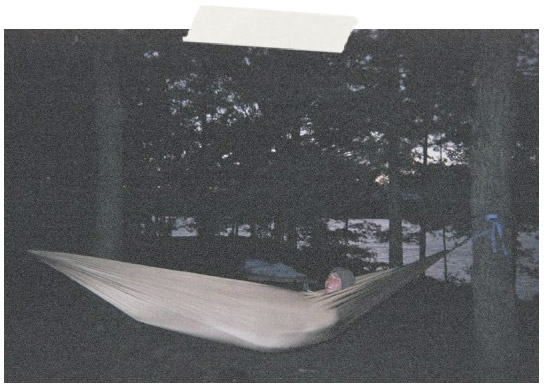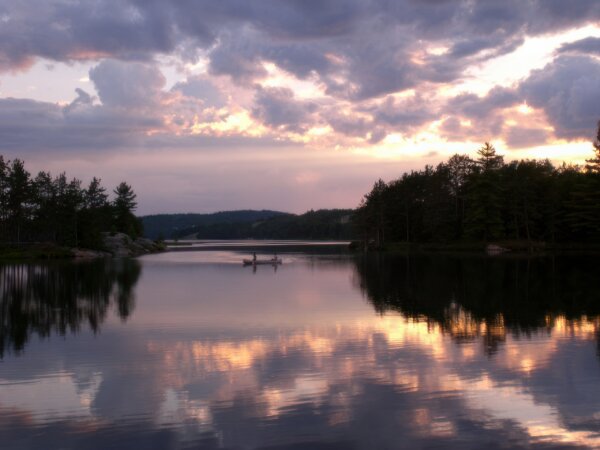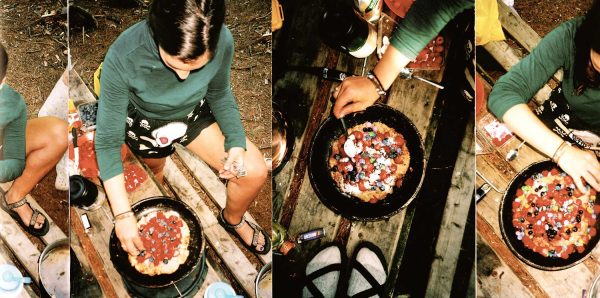Through the Eyes of a Tripper
Why I sleep in a hammock
Before the summer of 2007, my second year as a Walden tripper, I purchased the PEAK Gear Double Hammock. The design is simple; parachute material nylon about 6 feet across, bound at each end with an internal rope attached to two hooks. The setup is easy as well, requiring only two trees about 9 feet apart and some rope or webbing. Light and compact, even with necessary ropes and tarp, the hammock is a self-sustained sleeping system which is ideal for the weight conscious solo-tripper weary of humping around a bulky tent. Since I bought that hammock, I have used it as often as possible on trips, eschewing the confines of the tent for the resplendent night sky. For me, the hammock provides optimal comfort while allowing me the joy of sleeping outside.
For those who have never had the chance to sleep outside on a canoe trip, know now that you are missing out. Fall asleep beneath a canopy of dense foliage, stars peeking through the branches. Awake to a sunrise on the water and the cool morning air. Sure, it might not be for everyone. Sometimes it gets cold, or buggy or wet. But when its nice out, and a hard day of work has been put in, retiring to a hammock in the middle of the woods will always be my first choice.
Canoe tripping for me has always been centred around the two interconnected themes of proximity to nature and the idea of a self-sustaining system. When you go on a canoe trip as a cabin, a group of friends, or by yourself, you must ensure that you have everything necessary to sustain you for several days. When we trip, we set up camp on rather minimalist sites. At the end of a day, all you have waiting for you is a fire pit, a few logs for sitting on, and a box privy somewhere out in the woods. Everything else is up to you. Where you sleep, what you eat, what you wear; everything is dependant on what you have brought with you. Here we must strike a delicate balance between comfort and efficiency. Every extra pair of socks or bag of rice that you bring makes you go a little bit slower, and makes your trip that much harder. One of the great things about tripping at Walden is that by going in large groups we afford ourselves the ability to luxuriate ourselves. For example, you need a camping stove if you go on a trip, regardless of the size of the group. It is a backwoods necessity for times when it rains or when making a fire is unfeasible yet warm food still needs to be made. But regardless of the size of the group, you really only need one stove. When I trip by myself, I alone am responsible for carrying the stove. With a group of 10 or more, the weight of the stove each person has to carry is just a small fraction. So tripping the way we do at camp allows us to increase our comfort level without straining ourselves or voiding our efficient, self-sustaining system.
So keeping in mind these two ideals, closeness to nature and efficiency, the hammock has revealed itself to me as the optimal way to sleep in the woods. The benefits of sleeping outside are tremendous and hammocks are a light-weight method of refining the outdoor slumber experience above the simple (yet still often fantastic) dirt nap.
This is not meant to be an indictment of tents. Tents are great for what they are, the most efficient way of housing a group of people in the wilderness. In a tent, you still feel the ground beneath you and you can see the trees outside of you. Furthermore, Walden has seriously invested in brand new spacious tents which do a tremendous job of keeping the water out and comfortably sleeping half a dozen campers. Both the tent and the hammock allow for an experience which is unlike the common wood cabin – which is the norm at Walden and is duplicated throughout the country. A night in a cottage or a cabin is a night inside, a night on trip is an opportunity to sleep closer to nature, and an opportunity to enjoy the fruits of one’s labours. Often, the pillow-pack containing the tents is the heaviest, and being the camper in charge of lugging it around on a portage is an arduous task. But as with everything on trip, there is a reason and reward for the activity. It might be heavy to lug around all day, but at night you have this amazing shelter that nobody else is responsible for providing. When you get to a site, there is no cabin waiting for you. The tents, the very ones you have been portaging and paddling all day are all that you have, and you can sleep soundly knowing that only you and your fellow trip-mates had a hand in making sure that the tents got there.
The same can be said of almost everything on trip. People often ask why the food on trip is so good. People who have tried to replicate trip food in the city are often sadly made aware that it just doesn’t taste as good. Certainly the food we get is high quality, thanks to our fantastic kitchen staff who work with us every summer, and all trippers must be innovative and skilled chefs, and certainly there is a certain flavour imparted by a campfire that cannot be replicated. But what is really unique is that each person had a part in carrying the food that day, even if they did not. Doing any one job on trip makes you part of the whole system which is responsible for every part of the trip. If you carried a boat, or a pack, or paddles, or water bottles, or anything else, than you have contributed and you have been integral to the trip machine running efficiently and properly. The food tastes so good because every person on that trip helped in carrying it, paddling it, fuelling the fire, cooking it, seasoning it, saucing it and serving it. Taking part in making something happen means that enjoying it is that much better.
So what was I writing about? Hammocks? Well sometimes when I bring a hammock it means that one less tent has to be brought, meaning less weight for everyone to carry. Remember, every extra pound on trip is an extra pound that is carried by the entire group, not just the individual actually shouldering the load. I love my job, and would gladly do it for free (Sol, disregard that last statement.) I think it is an absolute privilege to be a canoe tripper at Walden, and it keeps me coming back summer after summer. Sleeping in a hammock makes me happy, and if it helps the trip as a whole in even a minor way than that is fantastic. So campers, if you see me luxuriating in my hammock on trip, now you know why I do it, and what it means for my canoe tripping experience.
— James Hirsh
Relating to this ‘sustainable system’ that Hirsh speaks of… check out the Packing Instructions that we have put together for parents and campers in hopes of raising the comfort level on Walden canoe trips!



Add your comment